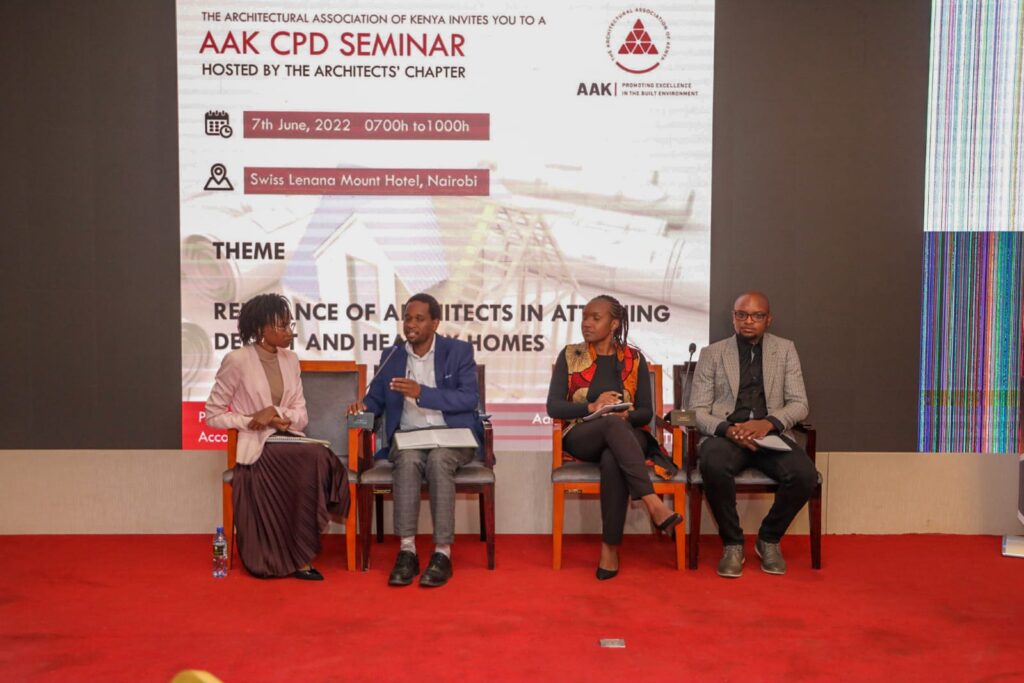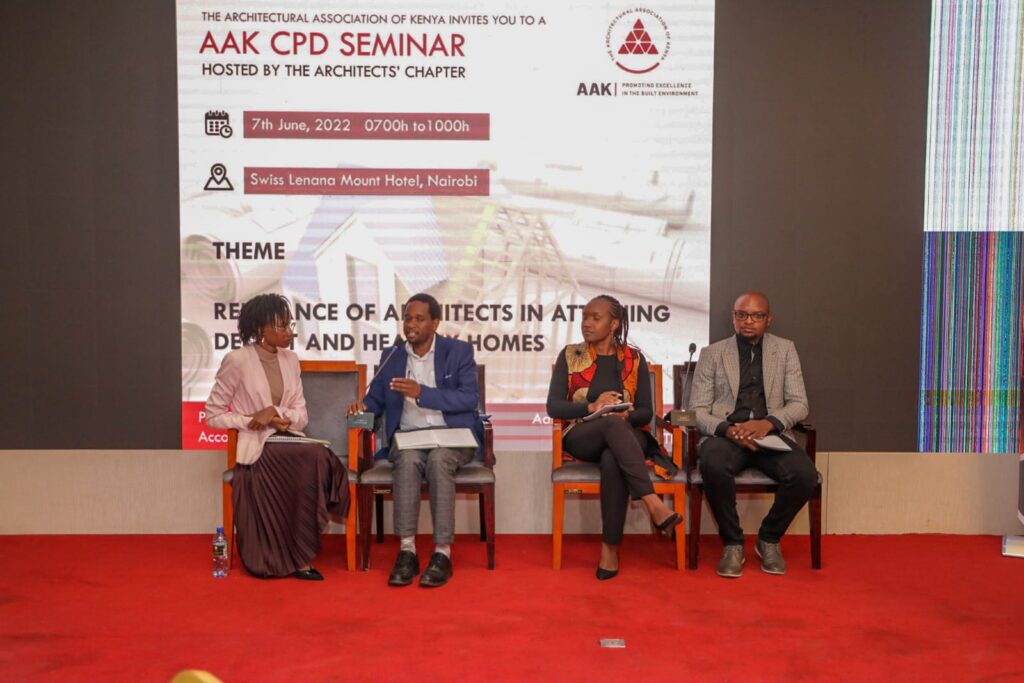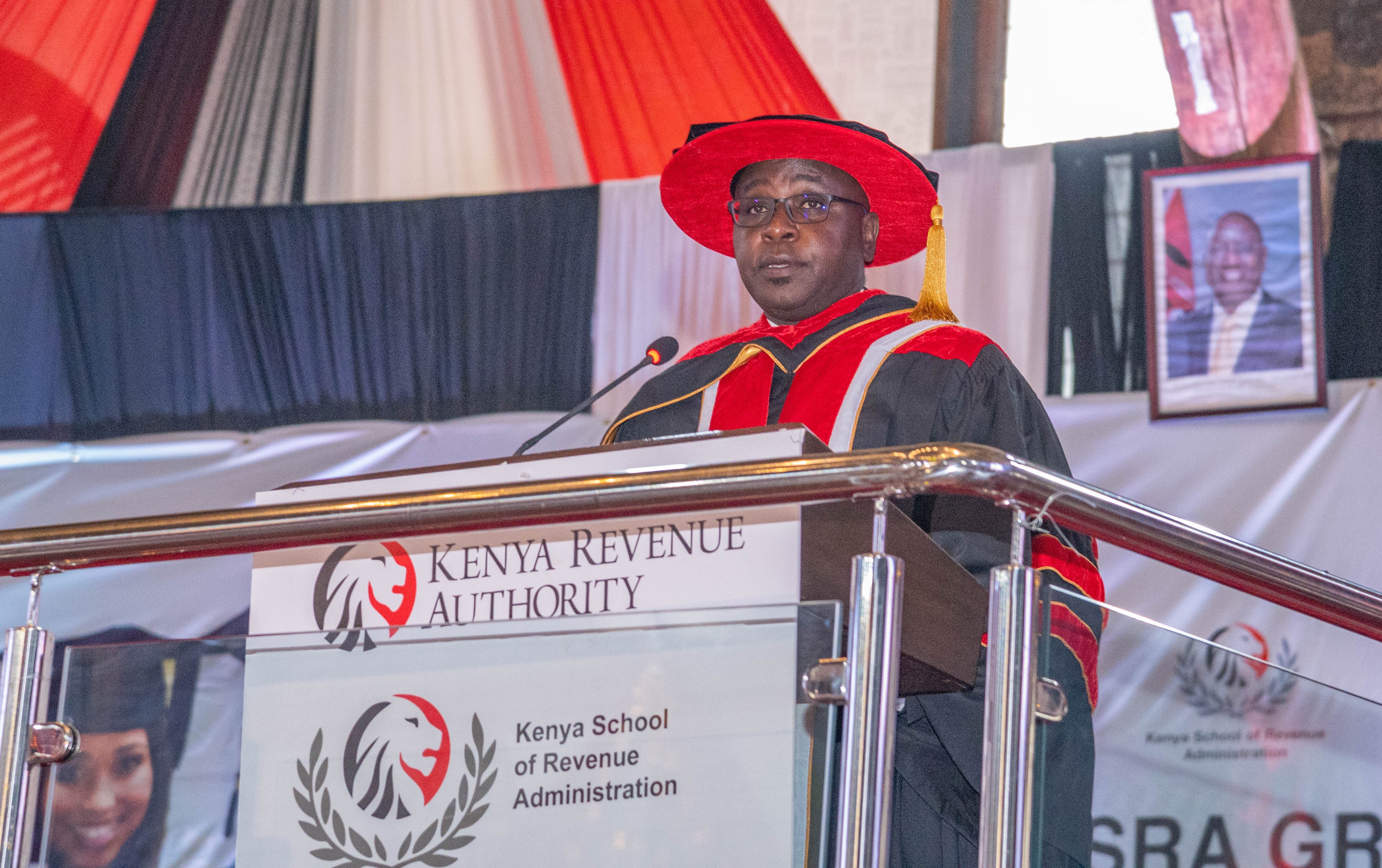AAK Hopeful of Good leadership

By John Kariuki
The Architectural Association of Kenya is calling upon the incoming administration to take seriously the issue of construction.
In a breakfast meeting held in Nairobi the Association cited complacency in the implementation of various laws relating to the building code.
The president of the Association Wilson Mugambi said for far too long the industry has suffered ups and downs and what they are asking for is for the government that will take over to address the matter seriously.
His sentiments were echoed by the vice president of the Association Florence Nyole who urged Kenyans to source competent and qualified experts when doing construction and civil works .
As you are aware, we are in an election year and the political temperatures are at a high note. Even as we listen to and digest the political discussions in the country, as an Association, we are cognizant of the fact that this is the time to make the right choices and elect candidates that have the potential to make transformative change in this country that will have a positive impact on the economy.
We are still reeling from the effect of the Covid pandemic that has affected each and every person globally. As we are recovering from this pandemic, our economy, like many other economies globally, has been affected by other factors that have resulted in steep increases in the cost of living causing untold suffering to many citizens.
The Construction sector, a major contributor to the GDP of this country and providing direct and indirect employment to millions of people has not been spared from the negative effects of these factors. It is our belief that we need steadfast leadership to improve the business climate and accelerate the recovery of the construction sector. There are a number of issues that we have identified that need to be placed as priority for the incoming leadership of this country, both at the national and county government level.
Kenya is a rapidly urbanizing country with a growing population but a massive deficit in housing. We need to elect leadership that will steer the urbanization of this country in an efficient and sustainable manner.
You may be aware that the Urban Areas and Cities Act provides clear guidance in the establishment and management of urban areas in Kenya. We call upon the government, especially county governments, to ensure that urban areas are established and managed according to the provisions of the Urban Areas and Cities Act (2019) as a matter of urgency. This is a matter that our Association takes seriously and has made the theme of this year’s AAK Annual Convention – A Holistic Approach to Urban Governance. This convention will be held on 6th to 8th July 2022 at the Sarova Whitesands and will be officiated by H.E. Lee Kinyanjui, Governor of Nakuru County and Kenya’s newest city and the Chairperson of the Urban Development, Housing, Planning. Energy, Infrastructure and Lands Committee at the Council of Governors. We will also be honoured to host the President of the International Union of

Architects Jose Luis Cortes at this event.
Dealing with construction permits remains a major challenge for professionals in the construction sector and property developers. While we have made efforts to automate this process, it remains a major pain point, with unscrupulous county government officers frustrating efforts to have the permits processed in an efficient manner. However, our members have continued to experience numerous challenges while applying for planning and architectural approvals in counties of Kenya, including Nairobi City County. In response to this, AAK undertook a survey to understand the challenges members face while using the e-permitting systems for Kiambu and Nairobi Counties. For Nairobi County, the Nairobi Metropolitan Services (NMS) migrated from the Electronic Development Applications Management System (eDAMS) to the Nairobi Planning & Development Management System (NPDMS), a move which has been dissatisfactory to the built environment professionals.
The migration was abrupt and lacked a proper transition, leaving applications that were already ongoing on e-DAMS stuck between the two systems. Several firms and individual professionals have also been unsuccessful in registering on the NPDMS, despite being registered by the relevant professional registration boards. Additionally, the new system links development proposals to land ownerships, allowing developers to initiate the processes, a step that is surely unnecessary. Most members also complained that the system is not user-friendly and requires too much information, some of which were unnecessary to the planning and design proposals. Similarly, 87.1% of members revealed that they have had to physically visit Kiambu County offices to follow up on applications over the last six months. This was because of frequent outages, downtime, and failure.
Numerous delays have been experienced while using these systems, with 80% of building and planning applications submitted still pending on the Kiambu County e-DAMS. Notably, the counties have no clear statement of the timelines for the various approval stages; most submitted plans have been pending for eight weeks, while some take up to one year without approval. With some pending projects valued at over KES 100 million, the delays could significantly affect the county’s business environment.
It was observed that some of the challenges the built environment professionals face result from the lack of proper communication channels, inadequate technical capacity at the county government level, and unscrupulous individuals who benefit from the systems’ failure through corruption. We continue to experience collapse of buildings, a clear indicator that the county governments have not hired and retained adequate and properly qualified staff to manage developments within their jurisdictions. We have raised this matter many times before and we say it again that the national and county governments must hire additional technical staff. We need commitment, especially from the candidates vying for Governor positions to commit to address this dire situation.
We are also aware that most of our urban areas do not have functional zoning regulations. This has led to disorderly developments. We call upon our incoming leadership at county level to commit to address this issue as a basis for propelling better organized, safe and healthy living environments in Kenya.
Kenya has a very robust ICT infrastructure that we must take advantage of, and ensure that we migrate most of these activities to the electronic platforms. We are pleased to note that the Ministry of Lands and Physical Planning is rolling out the ArdhiSasa and we trust that the system will be allowed to provide services as intended and not be disrupted by unscrupulous persons.
We also laud the efforts that have been made in the recent past toward the review of the Building Code, an exercise that started more than two decades ago. This process is now at the final steps. As we approach the election period, we implore the relevant state agencies, including the National Construction Authority, to complete the process as a matter of urgency so that as a new administration takes over, we have a solid basis to manage the quality of our development.
Ladies and gentlemen,
Aside from the construction permitting in Kenya, we have also identified climate justice as a key issue that the incoming government should focus on. Climate is a priority issue globally and we cannot avoid it, considering the already visible impact we see on our environment. The March 2022 Global Climate Report reveals that the last seven years have been the warmest ever recorded, with the sea level rising from 2013 to 2021. We need to take steps now to avert the effects of Global warming. Considering the construction industry is one of the biggest contributors to greenhouse gasses, the incoming government should advocate for adopting green building solutions in all upcoming developments.
Our Association has recently launched the Safari Green Building Index, a tool developed by Kenyans for Kenya. This tool is adapted to this region and if implemented, has the potential to increase the percentage of sustainable buildings in Kenya, reducing waste of energy, water and providing healthier environment and more productive citizens. Improved Business Environment: according to KNBS, over 1.4 trillion was used on road construction between 2013 and 2021, while contracts of over 1 trillion were awarded to foreign contractors. We implore that sustainable promotion of local content is a priority for the incoming administration. We also wish to point out that there is a need to reduce the red – tape and levies that make it increasingly difficult to conduct business in the sector. We can point to the recent re-introduction of the Environmental Impact Assessment Levy by the National Environmental Management Authority. The suspension of the NEMA levy, together with the levy charged by the National Construction Authority (NCA) was a positive step toward making it easier to do business in Kenya. We strongly condemn the reintroduction of the NEMA levy, an unnecessary step that would discourage investment in the sector.
Sustainable Infrastructure Development: Regrettably, many road projects implemented in the country are not inclusive nor people-friendly. In 2021, NTSA reported that 38% of road accident fatalities were motorcyclists, 35% were pedestrians, 17% were passengers, and 10% were drivers. Investment in infrastructure provision should be people-centered by catering to everyone’s needs. We urge the incoming government to ensure optimum budgetary and resource allocation for sustainable infrastructure projects.
We have also noted there has been minimal impactful development of mass transit systems in Kenya. We need to see adequate budgetary allocations being made to build and operate infrastructure to support mass transit systems such as BRT and commuter railways for the large cities such as Nairobi. Even as we laud the Nairobi Metropolitan Services, we also need to see investment to provide more, safer Non Motorised Transport in Kenya. This will improve the quality of life of Kenyans and place Kenya at the top of urban mobility in the region.





